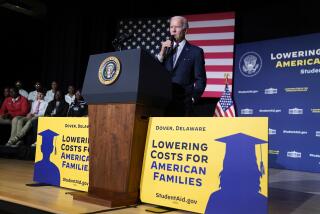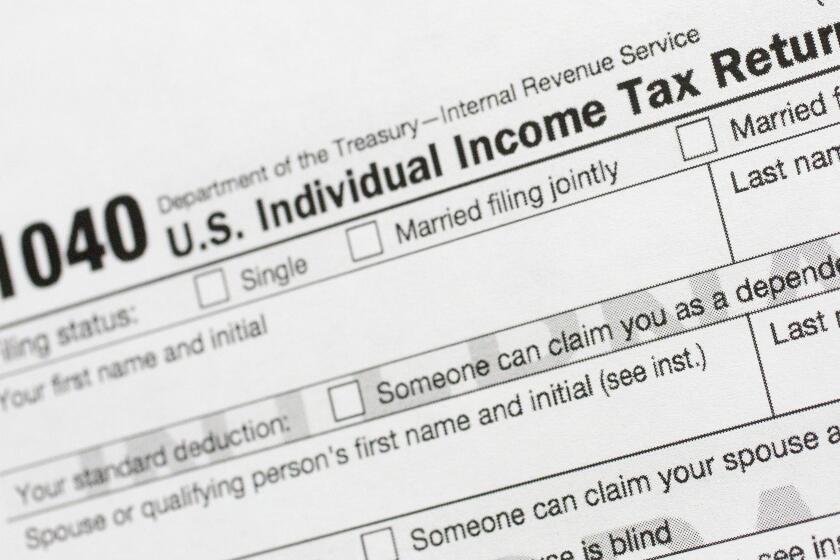Interest rates on student loans set to double next week
WASHINGTON — U.S. senators headed home for a Fourth of July recess without passing a bill that would prevent interest rates from doubling on student loans next week, leading to a ramp-up of political finger-pointing.
Last year, Democrats used the looming increase in the cost of student loans to great political effect, pressuring Republicans in an election year and rallying young voters in support of President Obama’s campaign.
Now, as a temporary extension of discounted interest rates is set to lapse, Democrats are at odds with one another over the issue, with the party’s leaders privately grumbling about a White House proposal nearer to Republicans’ solution than their own.
So Republicans are happily turning the political heat on Democrats.
“Interest rates on student loans are about to double because the president and Senate Democrats won’t resolve this impasse,” said House Speaker John A. Boehner (R-Ohio).
The divide among Democrats was evident in dueling press conferences Thursday.
In one, a bipartisan group detailed what they called a compromise plan that would bridge differences in market-based plans passed by the House, proposed by Senate Republicans and initially offered by Obama in his budget.
The other was attended only by Democrats, who for the second time proposed simply extending current rates for an additional year, the favored approach of the Senate’s leaders.
At a time when lawmakers face pressure to cut costs and reduce the deficit, the loan issue has invited an ideological debate over whether student borrowing should be a moneymaker for the federal government.
And there is a lot of money at stake.
A new report from the Joint Economic Committee showed that student debt has risen significantly, from $550 billion in late 2007 to about $1 trillion in the first quarter this year. The same report said that without congressional action, the higher Stafford interest rates would add $4,500 to the cost of a four-year college degree.
“The fundamental issue is whether the United States government should be making a profit off our students,” Sen. Elizabeth Warren (D-Mass.) said. “We should not be burdening our students further.”
But Sen. Angus King (I-Maine), one of the authors of the compromise plan, said federal student loans were not intended to be a subsidy program. “What we tried to do is design a system that was both fair to taxpayers and to students,” he said.
The sticking point for some Senate Democrats is that some of the market-based proposals would bring in hundreds of millions in new revenue at the expense of lower and middle-class students. The House Republican plan, for instance, would generate $4.7billion over 10 years.
At one press conference, Sen. Tom Harkin (D-Iowa), chairman of the Senate Health, Education, Labor and Pensions Committee, pointed to a chart criticizing the new Senate compromise plan, singling out one of its Democratic co-sponsors, Sen. Joe Manchin III of West Virginia.
“This is classic bait and switch. One or two years of low interest rates, then they sock it to you,” Harkin said.
He and the other sponsors said the one-year extension would give lawmakers ample time to consider a range of proposals to alter loan rates in concert with the reauthorization of the Higher Education Act.
After Democrats took control of both the House and Senate in 2007, Congress voted to lower the interest rates gradually on subsidized Stafford loans from 6.8% to 3.4%.
Just after Obama officially kicked off his 2012 reelection campaign, the president appeared on college campuses and on late-night comedy shows, prodding Congress to action with the rallying cry, “Don’t Double My Rate.”
His rival, Mitt Romney, eventually agreed to the idea, which spurred Republicans in Congress to agree on the one-year extension.
In his 2014 budget proposal for the Department of Education, Obama proposed restructuring student loan interest rates, linking them to the 10-year Treasury rate with differing surcharges for subsidized and unsubsidized Stafford Loans and PLUS graduate loans.
In May, the House passed legislation along party lines to do the same, though with slightly higher surcharges but an overall cap of 8.5% to protect student borrowers in the event of significant rate increases.
Another key difference was that Obama’s plan would lock in the initial rate for the life of the loan, while the House plan would have rates reset each year.
The Senate this month considered a plan from Senate Republicans that also used a market-based solution, as well as a Democratic plan to extend current rates for one year.
Neither plan achieved the 60-vote threshold to defeat a filibuster.
On Thursday, Democrats said they would call the one-year extension plan to a vote once again July 10, after the rates have doubled.
Since the House passed its proposal, Republican leadership has engaged in some of the same campaign-style tactics used in the past by Obama to criticize Democrats’ inability to advance their own plan.
Last week Republican leaders were joined by college students at their weekly news conference. Other House Republicans conducted Google hangouts on the issue this week.
“The president has failed to talk about this issue. He hasn’t lifted a finger to push his own party to pass his own proposal. The time for games is up,” House Speaker Boehner said.
Democratic leadership aides said some in the caucus saw value in a one-year extension that would bring the issue to a head in 2014, when the party again hopes to rally younger voters to the polls in congressional elections when turnout is typically lower.
The politics were complicated this year, they say, because the administration’s budget proposal went too far in the Republican direction, staking out a compromise position at the outset.
The politicization of the loan issue has made the prospects for other reforms in higher education programs more difficult, advocates say.
“There’s a set of things that we need to do that are more divisive than this, and we were unable to deliver on what … ultimately [should] be the easiest thing,” said Chris Lindstrom, director of the U.S. Public Interest Research Group’s higher education program.
More to Read
Inside the business of entertainment
The Wide Shot brings you news, analysis and insights on everything from streaming wars to production — and what it all means for the future.
You may occasionally receive promotional content from the Los Angeles Times.










